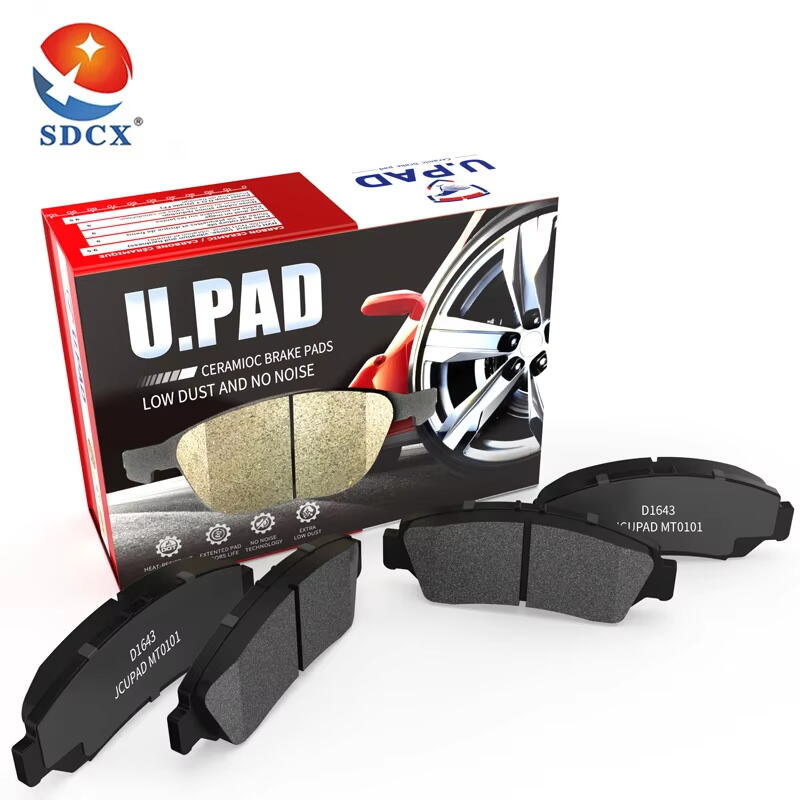Why Choosing the Right Automotive Brake Pads Matters
Impact on Vehicle Safety
Selecting the appropriate automotive brake pads is crucial for maintaining vehicular safety. Brake pads play an essential role in a vehicle's braking system by creating the friction needed to slow down or halt the vehicle. Utilizing subpar or unsuitable brake pads can significantly increase stopping distances, thereby elevating the risk of accidents. According to the National Highway Traffic Safety Administration (NHTSA), brake failure remains a common contributor to many vehicular accidents, highlighting the importance of choosing high-quality brake components. Ensuring optimal brake pad performance not only safeguards the driver but also enhances overall road safety.
Long-Term Cost Implications
Choosing the right brake pads extends beyond safety and enters the realm of long-term financial savings. Quality brake pads may carry a higher initial cost, yet they typically last longer and require fewer replacements, ensuring better cost efficiency over time. While the replacement cost for brake pads generally ranges from $150 to $300, investing in more durable options can result in significant financial savings in the long haul. By opting for superior brake pads, vehicle owners reduce the frequency of replacements and associated labor costs, thus enhancing the overall economic efficiency of vehicle maintenance.
Performance Consistency
The right brake pads ensure consistent performance across various driving conditions, thereby enhancing driver control and safety. Low-quality or incorrect pads can lead to inconsistent brake performance, potentially creating significant driving hazards. Research indicates that vehicles equipped with high-quality brake pads experience half the likelihood of performance failures compared to those using inferior options. By maintaining brake performance consistency, drivers can enjoy enhanced control, reduced wear and tear on the braking system, and increased confidence in their vehicle's ability to respond effectively in emergency situations.
Key Factors for Selecting Brake Pads
Vehicle Type and Weight Capacity
Choosing the right brake pads requires considering the type and weight capacity of your vehicle for optimal braking efficiency. Each vehicle, whether it’s a compact car, SUV, or truck, has specific requirements. Lighter vehicles generally benefit from softer brake pads that provide smoother stops, while heavier vehicles necessitate harder, more robust pads capable of handling greater forces. Studies have shown that using improper brake pads according to vehicle type can lead to increased wear and a shortened lifespan of the pads (LSI: Automotive Brake Pads). Therefore, it is essential to select brake pads that match your vehicle's specifications to ensure longevity and effectiveness.
Driving Conditions: City vs. Highway vs. Off-Road
Your driving conditions play a pivotal role in determining which brake pads are most suitable for your vehicle. City driving, with its frequent stops due to traffic, requires brake pads that can withstand heat and wear from constant braking. Conversely, highway driving involves higher speeds, which necessitates pads designed for effective high-speed stopping power. Off-road conditions demand specialized pads capable of handling dirt, mud, and tougher terrains without compromising performance. Each environment presents unique challenges that necessitate specific brake pad features to ensure optimal safety and efficiency.
Brake Pad Materials Explained
Understanding the differences between ceramic, metallic, and organic brake pads assists in making an informed choice. Ceramic pads are quieter and produce less brake dust, making them ideal for sensitive environments, but they may not perform well in extreme cold. Metallic pads offer superior performance under high heat, providing excellent stopping power, though they can be noisier. Organic pads consist of materials like rubber and glass and are known for their quiet operation; however, they tend to wear out faster. Research indicates that ceramic pads excel in high temperatures, while metallic pads offer better overall performance in various conditions. When selecting brake pads, consider material properties in relation to your driving requirements to achieve desirable braking performance.
Performance vs. Budget Considerations
High-Performance vs. Daily Driving Needs
Drivers need to consider whether they require high-performance brake pads for racing or if standard pads for daily commutes are more suitable. High-performance pads generally provide superior stopping power necessary for racing or sporty driving, but they may wear out faster, causing increased costs over time. Experts recommend aligning brake pad characteristics with driving styles to ensure optimal performance. For instance, those who drive primarily in city conditions may opt for pads that offer smoother and quieter performance, whereas racing enthusiasts might prioritize pads with enhanced braking capabilities that respond well in high-pressure scenarios.
Cost of Replacement vs. Longevity
While opting for cheaper brake pads might seem appealing initially, they often necessitate more frequent replacements, leading to heightened total expenses over time. Premium brake pads may carry a higher price tag upfront, yet they often offer increased longevity, thus reducing the overall expenditure. Generally, a cost-benefit analysis tends to favor investing in high-quality pads, as these components typically provide a longer lifespan, stronger performance, and potentially lower the frequency of replacements. Therefore, considering long-term costs rather than just the initial price is advisable for drivers looking to optimize both budget and brake performance.
Warranty and Brand Reputation
Choosing reputable brands can provide confidence in product quality, typically evident through comprehensive warranties and positive customer feedback. Brands with well-established reputations often come with long-lasting warranties, implying better reliability and higher customer satisfaction. Extensive research supports the view that top-rated brands enhance vehicle performance and mitigate the risks of brake failures. For instance, brands like ACDelco and Bosch are often praised for their dependable Products, which offer a balance of affordability and durability. Investing in a recognized brand ensures that drivers can benefit from both effective performance and peace of mind regarding their vehicle safety.
Installation and Maintenance Best Practices
Compatibility Checks
Ensuring that the selected brake pads are compatible with your vehicle's make and model is crucial for both safety and performance. Incorrectly matched brake pads can cause mounting issues, leading to malfunctioning brakes and increased wear on other components. To avoid these potential pitfalls, it is essential to verify the manufacturer’s specifications before making a purchase. This proactive step can save you from costly repairs and ensure a seamless replacement experience.
Bed-In Procedures for New Pads
Proper bed-in procedures are critical to ensuring that new brake pads function effectively. This process establishes the optimal contact surface between the pads and the rotors, enhancing brake performance and extending the life of the pads. Research indicates that failure to correctly bed-in the brakes can result in reduced braking efficiency and increase the likelihood of noise during braking. Therefore, following the appropriate procedures not only promotes safety but also improves the overall driving experience.
Signs of Wear and Replacement Timing
Recognizing the signs of brake pad wear and knowing the right time for replacement is vital for maintaining vehicle safety. Indicators such as squeaking noises or reduced braking response suggest that the pads may need replacing. Regular inspections are crucial as they help detect early signs of wear and prevent unexpected brake failures. Automotive safety experts recommend replacing brake pads before they reach 25% of their original thickness to ensure continued, reliable brake performance and safety.
Conclusion
Choosing the right brake pads is vital for enhancing both safety and the driving experience within a vehicle. By selecting appropriate brake pads, you can significantly boost vehicle safety and performance while also achieving long-term cost savings due to extended pad life and fewer replacements. Investing time in understanding your vehicle's requirements and specific driving conditions will pay off through enhanced performance reliability. Overall, making well-informed decisions regarding brake pad selection can contribute immensely to an optimal driving experience, ensuring that your vehicle responds efficiently and safely in various situations.
FAQs
How do automotive brake pads impact vehicle safety?
Automotive brake pads are crucial for vehicular safety as they create the friction needed to slow down or halt the vehicle. Using subpar brake pads can increase stopping distances and elevate the risk of accidents.
What are the long-term cost implications of choosing quality brake pads?
Quality brake pads, though initially more expensive, tend to last longer and require fewer replacements, resulting in long-term financial savings.
What factors should be considered when selecting brake pads?
Consider the vehicle type and weight, driving conditions, and brake pad materials (ceramic, metallic, organic) when selecting brake pads to ensure optimal performance.
How does brake pad material affect performance?
Ceramic pads are quiet and produce less dust but may not perform well in cold. Metallic pads offer high heat performance and stopping power. Organic pads are quieter but wear faster.

